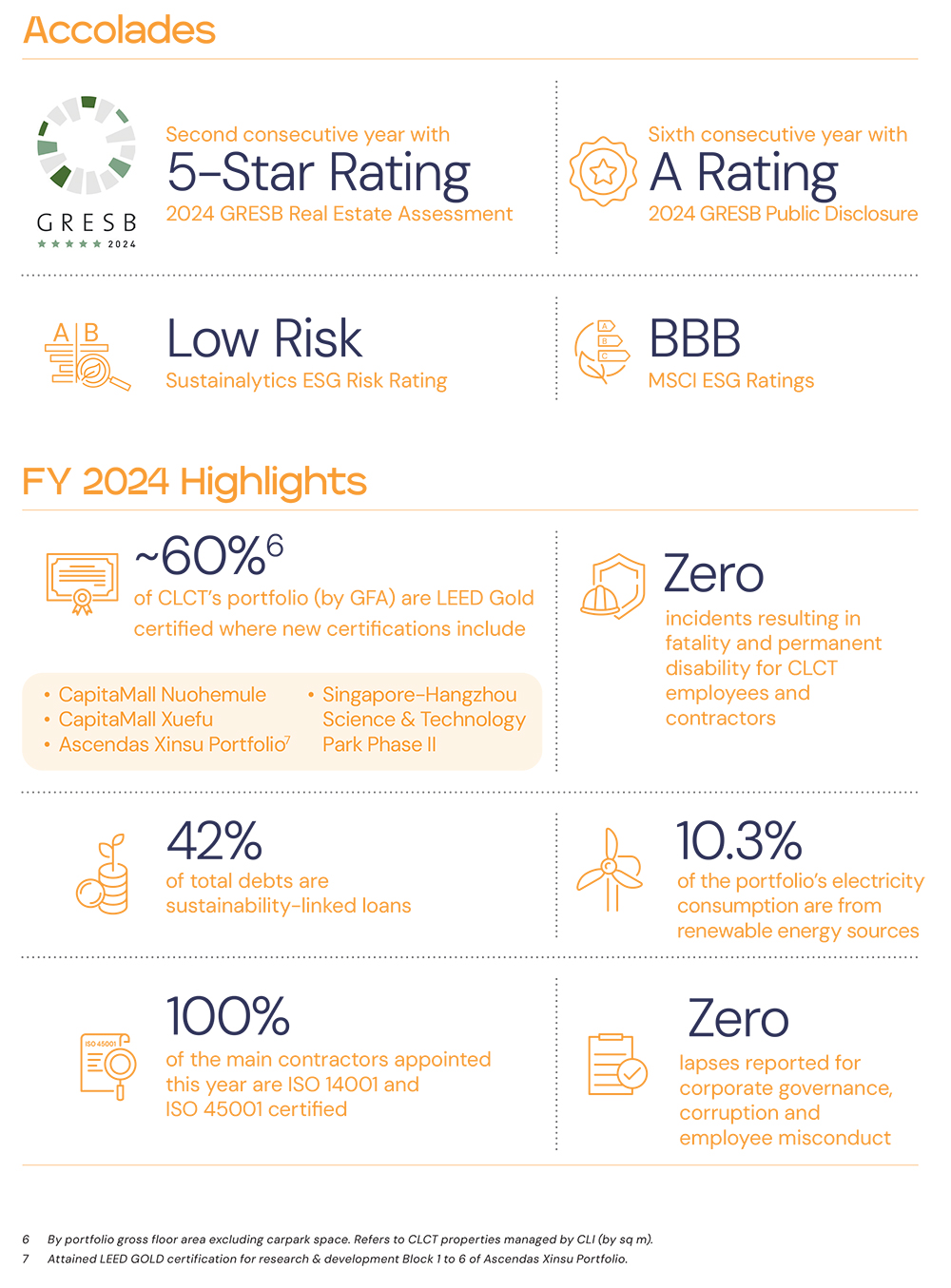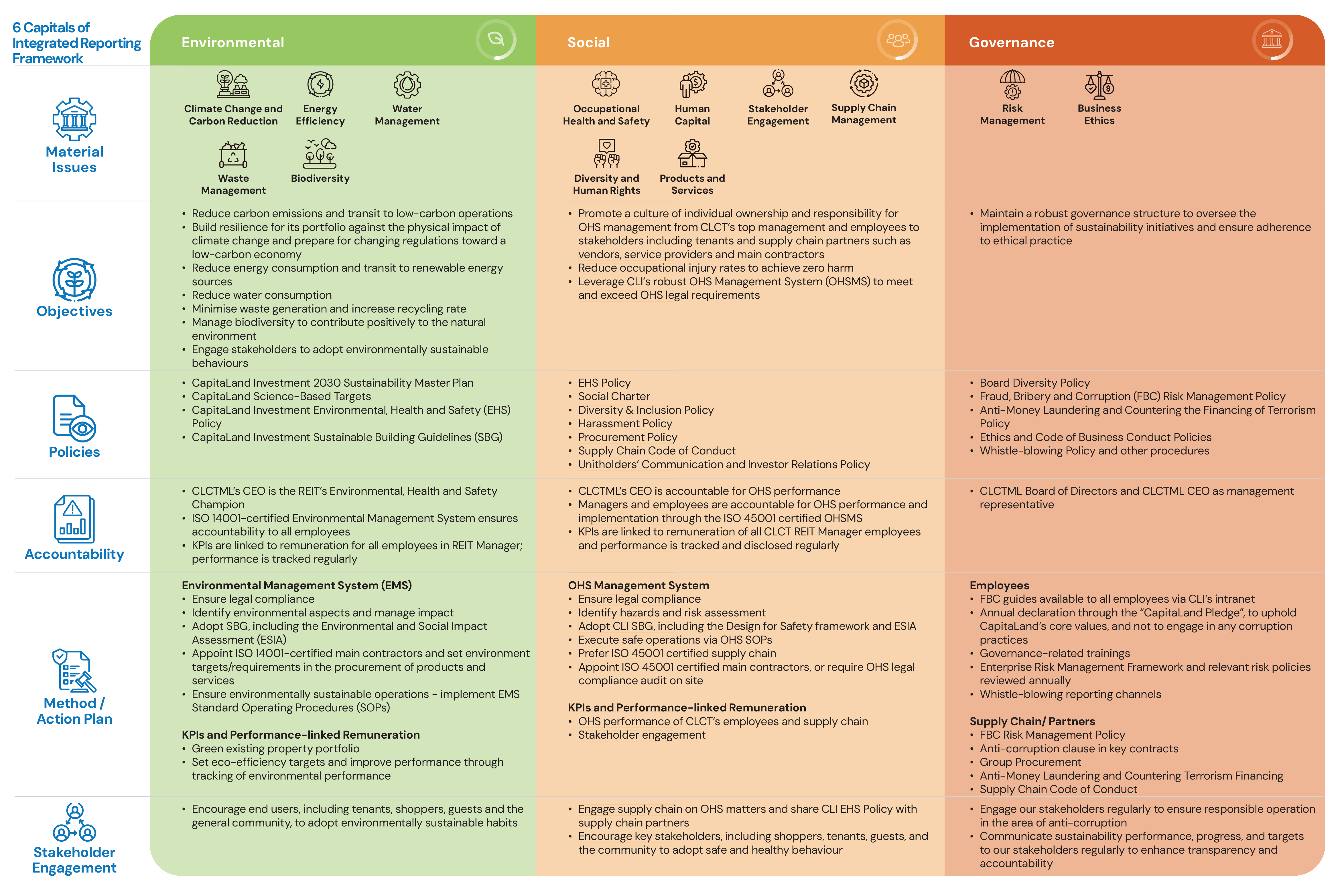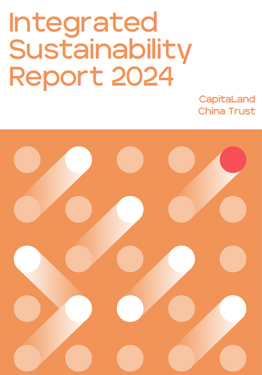PublicationsIntegrated Sustainability Reports
CLCT Integrated Sustainability Report 2024
Integrated Sustainability Report 2024
-
About this Report
CLCT’s fourth Integrated Sustainability Report (ISR) aims to provide a comprehensive overview of the organisation’s Environmental, Social and Governance (ESG) performance and reflects our ongoing commitment to responsible and impactful growth. Published in mid-April 2025, this Report is available on https://investor.clct.com.sg/isr.html.
International Standards And Guidelines
This ISR has been prepared in accordance with the Global Reporting Initiative (GRI) Standards 2021, an internationally recognised sustainability reporting standard that covers a wide range of disclosures. The Report is also in compliance with the sustainability reporting requirements set out in the Listing Manual Rule 711A and 711B of the SGX-ST.
Our business model is built upon the fundamental concepts as guided by the Integrated Reporting Framework by the Value Reporting Foundation, and it incorporates elements of the framework to communicate value creation. It is also aligned with the Sustainable Development Goals of United Nations (UN SDGs). Additionally, this Report references the Sustainability Accounting Standards Board (SASB) Standards sustainability disclosure topics and metrics for real estate sector-specific standards, and outlines CLCT’s risk management framework with reference to the Guidelines on Environmental Risk Management (EnRM) for Asset Managers issued by the Monetary Authority Singapore (MAS).
The IFRS Sustainability Disclosure Standards (IFRS SDS) issued by the International Sustainability Standards Board (ISSB), include IFRS S1 General Requirements for Disclosure of Sustainability-related Financial Information and IFRS S2 Climate-related Disclosures. In Singapore, mandatory climate-related disclosures will be phased in, requiring all listed issuers to start adopting ISSB standards from period starting 1 January 2025. Accordingly, this Report includes climate-related disclosures consistent with the recommendations of the Task Force on Climate-related Financial Disclosures (TCFD) and has taken reference from the IFRS SDS issued by the ISSB. CLCT is progressively incorporating climate-related disclosures under the Standards, in preparation for the Singapore Exchange Regulation enhanced sustainability reporting regime, effective for CLCT from FY 2025.
The above standards were selected as they are internationally recognised reporting frameworks covering a comprehensive range of sustainability disclosures relevant to CLCT.
Reporting Scope And Period
As at 31 December 2024, the portfolio comprised nine retail properties, five business parks and four logistics parks, primarily located in Tier 1 and leading cities in China. This Report discloses information on the 181, 2, 3 properties within CLCT’s portfolio, unless otherwise stated, for the financial period from 1 January 2024 to 31 December 2024 (FY 2024). This ISR covers CLCT as disclosed in our financial statements reported in the Annual Report (AR) 2024 (https://investor.clct.com.sg/misc/ar2024.pdf). Unless otherwise stated, the same approach used in our financial statements is also used to consolidate sustainability information and is consistently applied across our reporting boundaries for the financial period.
CLCT adopts the Greenhouse Gas (GHG) Protocol Corporate Standard in disclosing performance data for energy, GHG, water and waste across our 18 properties. As such, CLCT only reports the assets that are under the Manager’s operational control. There is no restatement of information this year.
Retail
- CapitaMall Xizhimen
- Rock Square
- CapitaMall Wangjing
- CapitaMall Grand Canyon
- CapitaMall Xuefu
- CapitaMall Xinnan
- CapitaMall Nuohemule
- CapitaMall Yuhuating
- CapitaMall Aidemengdun
Business Park
- Ascendas Xinsu Portfolio
- Singapore-Hangzhou Science & Technology Park Phase I
- Singapore-Hangzhou Science & Technology Park Phase II
- Ascendas Innovation Towers
- Ascendas Innovation Hub
Logistics Park
- Shanghai Fengxian Logistics Park
- Kunshan Bacheng Logistics Park
- Wuhan Yangluo Logistics Park
- Chengdu Shuangliu Logistics Park
CLCT’s properties are managed by the REIT Manager and property management teams. The respective teams are identified as employees of CLCT. Non-executive members of the CLCTML Board are not considered employees of the REIT.
This ISR has undergone a thorough internal review. To ensure transparency and accuracy, CLI continues to appoint an independent external consultant to externally assure its Global Sustainability Report (GSR) annually, with reference to the ISAE 3000 International Standard on Assurance Engagements. The scope of this external assurance engagement covers the CLI Group’s global portfolio and employees, including those of CLCT. CLI’s GSR 2024 will be published by 31 May 2025 on the CLI website.
The annually published ISR is recommended to be read alongside CLCT’s AR 2024 for a comprehensive understanding of its business and performance. Reflecting our ongoing commitment to environmental sustainability, no physical copies of this ISR have been printed.
Location of Disclosures
This year, information required under GRI 2021, TCFD, MAS EnRM and the IFRS SDS may be included in the sustainability report by cross-referencing to another source. We have provided the references in the GRI content index as to where this information can be found within the ISR.
For any further inquiries, please contact:
Ms Nicole Chen
Head, Investor Relations
Tel: 6713 2888
Email: ask-us@clct.com.sg
Website: www.clct.com.sg1 CapitaMall Qibao ceased operations in March 2023 and is therefore not included in the Report.
2 CapitaMall Shuangjing is not included in the environmental, social and governance operational data reporting as the Manager does not have operational control over the asset. The mall was divested in January 2024.
3 As CLCT’s logistics park assets are not operated by CLI, the energy and water data of these assets are not included in the portfolio’s environmental performance. The emissions data of these assets are included under Scope 3. -
CEO Message
Dear Stakeholders,
FY 2024 has been a meaningful year for our sustainability journey, a year of progress and continuance of our commitment to sustainability. Guided by CLI’s 2030 SMP, our goal remains to deliver long-term and lasting value for our stakeholders. We are pleased to share the latest milestones and achievements in our sustainability journey, and we strive to maintain steady progress forward.
Sustainability Recognition And Accolades
This year, we are proud to celebrate significant achievements that reflect our dedication to sustainable practices. For the second consecutive year, we achieved a 5-star rating in the 2024 GRESB Real Estate Assessment, alongside an “A” rating for the 2024 GRESB Public Disclosure with a score of 100 points. We also maintained a ‘BBB’ rating for our MSCI ESG Ratings and attained a ‘Low Risk’ rating for the Sustainalytics ESG Risk Ratings this year. Overall, these accomplishments inspire us to maintain our momentum and continue striving for impactful sustainability efforts.
Sustainable Operations
We integrated sustainable practices across our operations and portfolio, with a particular focus on energy efficiency. This has yielded positive results, with four of our assets – CapitaMall Nuohemule, CapitaMall Xuefu, Ascendas Xinsu Portfolio4 and Singapore-Hangzhou Science & Technology Park Phase II attaining LEED Gold certification in 2024. With this, approximately 60%5 of CLCT’s portfolio, by gross floor area (GFA), are green certified. This marks a substantial increase from 36% of CLCT’s portfolio in 2023, and we are committed to continue our efforts to integrate sustainability principles into our everyday operations.
Furthermore, we have made significant strides in integrating renewable energy into our portfolio this year. Renewable energy accounts for 10.3% of our portfolio’s electricity consumption in FY 2024, representing an increase from 3.0% in FY 2023. We purchased offsite renewable energy with CapitaMall Yuhuating, CapitaMall Xinnan, Ascendas Xinsu Portfolio, Ascendas Innovation Hub, Ascendas Innovation Towers, Singapore-Hangzhou Science Technology Park Phase I and Singapore-Hangzhou Science Technology Park Phase II, and have installed onsite solar panels at CapitaMall Yuhuating and Kunshan Bacheng Logistics Park.
Sustainable Financing Journey
Building upon our progress in FY 2023 where CLCT established its Sustainability-Linked Finance Framework, we continue to advance in our sustainable financing journey. As of 31 December 2024, sustainability-linked loans account for 42% of total debt, a steady increase from 31% in FY 2023. This improvement demonstrates our dedication to responsible growth and our focus on embracing sustainable financing instruments to strengthen our financial flexibility.
Embracing Diversity And Inclusion
We recognise that diversity and inclusion are integral to fostering innovation and driving growth. As of 31 December 2024, 37.5% of our Board of Directors comprises female leaders, with three out of eight directors being women. Additionally, we continue to maintain a strong focus on gender diversity within our REIT Manager and property management teams across Singapore and China. Extending beyond gender representation, we also prioritise diversity in experiences, backgrounds, and perspectives to foster a well-rounded and inclusive working environment for all.
Sustainability Stewardship
Sustainability remains central to our everyday activities and strategies here at CLCT. We embed ESG targets into our investment and operational decision-making, striving to continuously elevate our sustainability performance and sustainable financing endeavours. By fostering resilience and embracing opportunities, we remain dedicated to contributing to the environmental and social well-being of the communities we serve.
We extend our sincere gratitude and appreciation for your ongoing support and steadfast partnership as we advance on this sustainability journey together.
CHAN KIN LEONG GERRY
Chief Executive Officer
4 Attained LEED GOLD certification for research & development Block 1 to 6 of Ascendas Xinsu Portfolio.
5 By portfolio gross floor area excluding carpark space. Refers to CLCT properties managed by CLI (by sq m). -
Sustainability Highlights

-
Environmental, Social and Governance Framework

Policies
Environmental
Social
Performance
Appendices
For more information, click here for our full Integrated Sustainability Report 2024 and here for our Annual Report 2024.
Previous Integrated Sustainability Reports
| Year | Title | |
|---|---|---|
| 2023 | CLCT Integrated Sustainability Report | |
| 2022 | CLCT Integrated Sustainability Report | |
| 2021 | CLCT Integrated Sustainability Report |


 Environmental
Environmental
 Social
Social
 Governance
Governance



